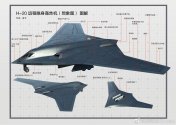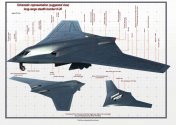Regarding the stealth performance of J-20, you can take a look at this.You're strawmanning me.
1.
Maneuverability still matters, but significantly less so since there's now a plethora of long-ranged missiles which apparently have good NEZ and effective range.
Think of when NATO got their hands on the Soviet HOBS missiles. The conclusion was that while maneuverability still matters, the game has changed from getting on someone's six to putting someone into your HOBS cone while they're outside of yours. And these HOBS cones are massive; multiple km in distance, and with the latest improvements in radar, you're looking at 30 km or more. That's not traditionally considered WVR.
The other big advantage of maneuverability is that you can reduce the enemy missile's effective range against you, or force the opponent to fire more missiles. That's to say, missiles have a maximum range as well as an effective range. At maximum range, they're mostly energy-spent and no longer have the energy to track and hit an agile target. At effective range, the missile has enough energy to lock onto the most agile targets imaginable. The maneuverability of the fighter dictates how long the effective range is.
But in the stealth realm, you can skirt deep into the enemy missile effective range provided you're not seen. Then you can still get a first shot off, perhaps from data-linked teammates. So kinematic effective range is not the only factor determining who gets to shoot first and who gets to go home alive / in their plane.
2.
J-20 makes quite a few stealth mistakes. It's considered stealthier than the Su-57, but that might have more to do with design emphasis and coatings. For instance, the canards are not coplanar with the opposite wing, which would reduce emissions. Compared to the F-22 and F-35, from a frontal view, you have 3-6 planes whereas the F-22 and F-35 only have two.
From amateur RCS studies (see Secret Projects), there's major spikes generated by the canards at a 45 degree angle. Since this is not a frontal-facing RCS spike, this isn't such a big deal, but if the opponent knows it's there and how to look for it, it could prove a problem.
It also places a major emphasis on Chinese RWR. Stealth is about emissions tracking; i.e, knowing where the emitters are and making sure they see all the wrong angles.
3.
The F-35 is not an all-aspect stealth design. When it comes to minimum RCS, it probably beats the F-22, but it's a very strong stealth design since the main wing can hide the tail (but canards can't hide the main wing). There's obviously issues with the F-35, but it all depends on angle.
4.
Read up on NGAD. It's apparently ahead of schedule due to the US DOD's new design process. It's intended for rapid prototyping, which is a strength of Chinese private manufacturing, but state-owned, not so much.
Lockheed apparently just broke ground on a LRIP factory for it.
You are using an out of date browser. It may not display this or other websites correctly.
You should upgrade or use an alternative browser.
You should upgrade or use an alternative browser.
H-20 bomber (with H-X, JH-XX)
- Thread starter Deino
- Start date
This is fan art, right? Nothing official?
PiSigma
"the engineer"
Correct. The characters in the brackets say (imaginary graphic)This is fan art, right? Nothing official?
Thanks!Correct. The characters in the brackets say (imaginary graphic)
Not a very convincing imaginary graphic either. It is based largely on the B-2, but with outline altered for no clear reason to make it less stealthy.
I think a real stealth bomber would look more like the B-2 in RCS governed outline, and less like the B-2 in discretionary design detail.
I think a real stealth bomber would look more like the B-2 in RCS governed outline, and less like the B-2 in discretionary design detail.
From the AVIC promo video the H-20 is likely to be a cranked arrow design. It's less of a true flying wing, likely because either the cranked arrow design provides more lift or it provides more volume for bomb space compared to a B-2-style flying wing.Not a very convincing imaginary graphic either. It is based largely on the B-2, but with outline altered for no clear reason to make it less stealthy.
I think a real stealth bomber would look more like the B-2 in RCS governed outline, and less like the B-2 in discretionary design detail.
I mentioned previously that stuff like the Su-34, F-15E, etc, can reach like 12,000 kg bomb capacity, the B-21 is going to be around 14-16 tons, and the B-2 reaches 20 tons. Consider, however, that the first are strike aircraft / fighter-bombers, the second is a medium bomber, and the third is a heavy bomber. The stealth-oriented B-2 design seems extremely limited in payload compared to the strike aircraft / fighter bombers; i.e, some stealth might be worth sacrificing if you can increase the size of the bays.
Moreover, if we're doing a B-21 vs H-20 comparison, the H-20 is substantially larger than the B-21 if the rumors are true, so "small features" that would ruin stealth aren't small at all and might be comparable to "large features" on the B-21 that preserve stealth fully.
From the AVIC promo video the H-20 is likely to be a cranked arrow design. It's less of a true flying wing, likely because either the cranked arrow design provides more lift or it provides more volume for bomb space compared to a B-2-style flying wing.
...
Once again you rate a random fan art as being an official AVIC release or again, could you please add this AVIC promo video image that leads you to the conclusion of a "cranked arrow design"!
At least by my understanding none of the only true official AVIC releases show any details which hint such a wing and therefore - similar to our last discussion based on that Aerospace Knowledge" cover image which you misread as being "official", there is nothing yet, which would justify ANY reasonable estimation of configuration, planform, dimensions and even more capabilities.



These strips are comprised of reliable metal bars or several closely spaced buttons of conductive material attached to a plastic strip that is glued to the radome. In several ways, diverter strips act similar to a lightning rod on a skyscraper.
Look at the bottom picture closely, and compare it to the B-2 / B-21 underneath tarp. If you note, the angle of the tarp line changes substantially, in such a way that suggests that what we are seeing is a change in the wing sweep; i.e, cranked arrow.Once again you rate a random fan art as being an official AVIC release or again, could you please add this AVIC promo video image that leads you to the conclusion of a "cranked arrow design"!
At least by my understanding none of the only true official AVIC releases show any details which hint such a wing and therefore - similar to our last discussion based on that Aerospace Knowledge" cover image which you misread as being "official", there is nothing yet, which would justify ANY reasonable estimation of configuration, planform, dimensions and even more capabilities.
View attachment 76994View attachment 76995View attachment 76996


